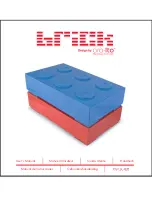
18
Momentus 4200.3 PATA Product Manual, Rev. B
Korean RRL
If these drives have the Korea Ministry of Information and Communication (MIC) logo, they comply with para-
graph 1 of Article 11 of the Electromagnetic Compatibility control Regulation and meet the Electromagnetic
Compatibility (EMC) Framework requirements of the Radio Research Laboratory (RRL) Ministry of Information
and Communication Republic of Korea.
These drives have been tested and comply with the Electromagnetic Interference/Electromagnetic Susceptibil-
ity (EMI/EMS) for Class B products. Drives are tested in a representative, end-user system by a Korean-recog-
nized lab.
EUT name (model numbers): ST980811A, ST960813A, and ST9408116A.
Certificate number:
STX-L253 (B)
Trade name or applicant:
Seagate Technology International
Manufacturing date:
January 2006
Manufacturer/nationality: Seagate
Technology
International
Australian C-Tick (N176)
If these models have the C-Tick marking, they comply with the Australia/New Zealand Standard AS/NZS3548
1995 and meet the Electromagnetic Compatibility (EMC) Framework requirements of the Australian Communi-
cation Authority (ACA).
2.14.3
FCC verification
These drives are intended to be contained solely within a personal computer or similar enclosure (not attached
as an external device). As such, each drive is considered to be a subassembly even when it is individually mar-
keted to the customer. As a subassembly, no Federal Communications Commission verification or certification
of the device is required.
Seagate Technology LLC has tested this device in enclosures as described above to ensure that the total
assembly (enclosure, disc drive, motherboard, power supply, etc.) does comply with the limits for a Class B
computing device, pursuant to Subpart J, Part 15 of the FCC rules. Operation with noncertified assemblies is
likely to result in interference to radio and television reception.
Radio and television interference. This equipment generates and uses radio frequency energy and if not
installed and used in strict accordance with the manufacturer’s instructions, may cause interference to radio
and television reception.
This equipment is designed to provide reasonable protection against such interference in a residential installa-
tion. However, there is no guarantee that interference will not occur in a particular installation. If this equipment
does cause interference to radio or television, which can be determined by turning the equipment on and off,
you are encouraged to try one or more of the following corrective measures:
• Reorient the receiving antenna.
• Move the device to one side or the other of the radio or TV.
• Move the device farther away from the radio or TV.
• Plug the computer into a different outlet so that the receiver and computer are on different branch outlets.
If necessary, you should consult your dealer or an experienced radio/television technician for additional sug-
gestions. You may find helpful the following booklet prepared by the Federal Communications Commission:
How to Identify and Resolve Radio-Television Interference Problems. This booklet is available from the Super-
intendent of Documents, U.S. Government Printing Office, Washington, DC 20402. Refer to publication num-
ber 004-000-00345-4.
Summary of Contents for ST9408116A
Page 1: ...Product Manual Momentus 4200 3 100398880 Rev B August 2007 ST980811A ST960813A ST9408116A...
Page 4: ...ii Momentus 4200 3 PATA Product Manual Rev B...
Page 6: ...iv Momentus 4200 3 PATA Product Manual Rev B...
Page 8: ...2 Momentus 4200 3 PATA Product Manual Rev B...
Page 26: ...20 Momentus 4200 3 PATA Product Manual Rev B...
Page 30: ...24 Momentus 4200 3 PATA Product Manual Rev B...
Page 48: ...42 Momentus 4200 3 PATA Product Manual Rev B...
Page 49: ......
















































